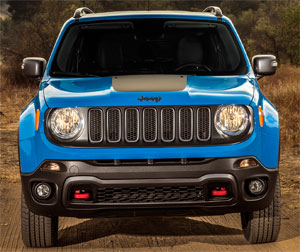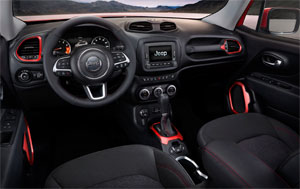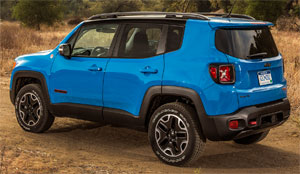2015 Jeep Renegade
While we as automotive enthusiasts tend to be wary of returning nameplates, as they rarely live up to the cars that originally used them, it can be done with success, as jeep proved with the new cherokee. Well, with that success in hand, jeep is now focused on the rapidly growing small crossover segment, and has placed the venerable Renegade name on an new model, with a new DNA.
Renegade is defined as “one who deserts or betrays an organization.” So it’s a fitting nameplate for the 2015 Jeep Renegade, as it enters into a new segment for brand, and is clearly unlike any other jeep in the stable… …or is it?
Jeep fans know that renegade not as a model name, but rather a trim package found mostly on cjs and wranglers.
And while early photos, with its borderline-cartoonish appearance, made it hard to take seriously, in person, the subcompact renegade sports much better proportions while still saying classic jeep up front. But, less so in the rear ¾ view with the upwardly arched quarter windows. But, the x-motif in the taillights and elsewhere, playing off a ww II-style fuel can, is pretty cool.
As for its new DNA, the renegade is on fiat’s small-wide 4x4 platform that it shares with the 500l and upcoming 500x. Built in Italy, FCA hopes renegade will make jeep as popular in global markets as it is here.
 One feature we haven’t seen on other new smallish-utes is removable roof panels. Renegade’s basic mysky system has two separate pieces that, when taken off, deliver some of that open air experience jeeps are known for. Mysky with a power sliding front panel is also available.
One feature we haven’t seen on other new smallish-utes is removable roof panels. Renegade’s basic mysky system has two separate pieces that, when taken off, deliver some of that open air experience jeeps are known for. Mysky with a power sliding front panel is also available.
There’s not an abundance of room in the comfortable front seats, but more than you’re expecting; and that just means all of the controls fall close to hand.
Seat controls were manual in our latitude-trimmed tester, but they’re very beefy felling, not compact car flimsy. The instrument panel looks nice, if a bit gimmicky. there’s jeep logos and “since 1941” script everywhere. It can get a bit cheesy and some materials are more economy than rugged.
The uconnect screen is on the small side, but it gets the job done, and the overall look of the interior will undoubtedly appeal to the younger set. Rear seat room is good, but the seatbacks don’t quite fold flat for cargo.
And while total cargo space is decent at 50.8 cubic-ft; 18.5 behind the rear seats; it falls well short of the Honda HR-V. Also, the mysky panels storage bag takes up a lot of floor space.
Now, jeep wanted to make sure you can still do jeep-type things in the renegade, and the trailhawk model features a standard active drive low 4x4 system with terrain select modes for snow, sand, mud, and rock. It’s clearly the only suncompact ute designed for true off-road use.
 And you can still get jeep’s regular-strength active drive full-time 4x4 system in all other trims, which worked fine for us.
And you can still get jeep’s regular-strength active drive full-time 4x4 system in all other trims, which worked fine for us.
On road, the renegade feels very car-like, with minimal roll in corners and heavy steering. It’s a solid package overall, with no squeaks or rattles from the roof panels, though wind noise can ring out at speed.
As for powertrains, there are two. The larger, 2.4-liter tigershark I4 boasts 180-horsepower, and 175 lb-ft. of torque. Though a little rough at idle, there’s an impressive amount of power for a segment that mostly consists of sub-2.0-liter engines.
And of course there is one of those available here as well, fiat’s 160-horsepower 1.4-liter multiair turbo-4 which comes with a 6-speed manual.
The 2.4-liter gets a 9-speed automatic which worked okay. There’s still some occasional stumbling, but it’s definitely an improvement over early cherokees.
At our test track, the 2.4 renegade snaps off the line like a sprinter, but quickly settles down into a marathon pace; reaching 60 in 8.6-seconds. Leisurely shifts compound the ¼-mile situation, which took 16.5-seconds to climb to 83 miles-per-hour.
 A relaxed pace was the way to go through our cone course too; as anything more, turns manageable understeer into full-on plow. An average stopping distance of 120-feet from 60 was not bad, but random locking and an unsettled rear needs to be improved upon.
A relaxed pace was the way to go through our cone course too; as anything more, turns manageable understeer into full-on plow. An average stopping distance of 120-feet from 60 was not bad, but random locking and an unsettled rear needs to be improved upon.
Government fuel economy ratings for a 2.4 4x4 are 21-city, 29-highway, and 24-combined. Our average of 25.4 of regular is certainly superior to an old xj; but we expected better from such a small-fry. Still the energy impact score of 13.7-barrels of oil use and 6.1-tons of annual CO2 emissions is healthier than average.
We think jeep’s first attempt at a truly global small crossover will represent the brand well throughout the world, as it will be available in more than 100 countries. Pricing here in the good old U.S. of America starts at $18,990 for a sport; 4-wheel-drive adds 2-grand more.
So, while its origins are off-shore, the 2015 Renegade still embodies much of what has made the jeep brand an American icon. Combined with a low price, it’s the perfect jeep for people who think they want a jeep, but really want a rugged-looking small crossover with all of the modern comforts they’ve become accustomed to. so, renegade is one traitor with a good cause.
Specifications
- Engine: 2.4 liter / 1.4-liter
- Horsepower: 180 / 160
- 0-60 mph: 8.6 seconds
- 1/4 mile: 16.5 seconds @ 83 mph
- EPA: 21 mpg city/ 29-highway
- Energy Impact: 13.7 barrels of oil/yr
- CO2 Emissions: 6.1 tons/yr
2024 Polestar 2
More Range And More Power For The Polestar 2
Volvo is well on their way to making the transition to an all-electric brand, but their sister-brand Polestar is already there. Now, we’ve spent lots of time in their all-wheel drive, five-door Polestar 2, having tested it in 2021, and a year later when a two-wheel drive version arrived. But, EV updates are coming quickly. So, let us be your guide for all that’s new with the Polestar 2.
While we are driving more EVs than ever, we’ve also been spending a lot of time recently circling back to ones we’ve previously tested. As in this new era of electrified vehicles, significant updates are arriving quickly, with R&D investments increasing and retrofitting them easier than ever. This is often done through software updates that can even be accomplished over the air. For 2024, the Polestar 2 has indeed gotten some software updates, but some physical ones as well.
Clearly aimed directly at Tesla’s Model 3 when it arrived; the Polestar 2’s build quality was vastly better, but range definitely came up short. So, addressing that was priority No. 1; and for ’24 the Polestar can travel up to 20% farther than before while consuming 9% less energy, and when it comes time to charge it back up, it can do that 34% faster too.
Range in the Single Motor version increases from a max of 270 to 320 miles thanks to a larger 82-kWh battery pack, and that solitary motor now powers the rear wheels, not the front wheels. It’s also bigger, coming in at 220 kW compared to the previous 170 kW front-wheel drive version, going from 231 to 299 horsepower.
Dual Motors keep the same 78-kWh battery, but still sees a boost from 260 to 276 miles and takes advantage of the larger rear motor for a new combined 310-kW output with 421 horsepower. Our test car has the added Performance Pack, which uses an additional 35 kW to deliver 455 horsepower and 546 lb-ft of torque, though max range drops to just 247 miles.
The new battery in rear-drive 2s will also charge faster, now accepting up to 205 kW for an 80% charge in 20 minutes; max for dual-motors stays at 155 kW, which puts an 80% charge at 34 minutes. Using 32 kWh of electricity per 100 miles, the Dual Motor earns a good efficiency rating.
The [Polestar] 2 has always been one of the most enjoyable EVs to drive, even more so now with that additional power coming from the rear motor.
Unfortunately, extremely cold temperatures kept us from seeing that increased range, as we were only on pace for about 194 miles in our test.
The 2 has always been one of the most enjoyable EVs to drive, even more so now with that additional power coming from the rear motor. And especially when equipped with the Performance Pack as it not only includes more power, but adds 20-inch forged wheels, upgraded brakes, and adjustable Ohlins Dual Flow Valve performance dampers. It greatly improves handling prowess without affecting ride quality, and is easily worth the $5,500 charge if you at all enjoy driving.
Even on a 20-degree track day there was plenty of grip through our handling course. No understeer or oversteer, and lots of feedback through the wheel. There was a nice, strong launch off the line that properly planted us firmly in the seat, and rocketed us to 60 in 4.5 seconds. Power delivery stayed pretty intense up until about 80 mph when there was a definite tapering off. Still, it was a 13.4-second quarter-mile at 102 mph; smooth, quiet, and stable the whole way.
When this car debuted, its Google-based infotainment setup was a novelty, but since then, more and more manufacturers are just “Googling it” so it doesn’t seem out of place at all. The wireless phone charger is easy to access, and there’s a great Harmon/Kardon sound system and panoramic sunroof to enhance the in-cabin experience. Exteriors have also been enhanced with a smooth grille insert and new wheel choices.
Hatchback practicality means 14.3 cu-ft of easy to access cargo space with split-folding seatbacks for longer items and expanding the space to 38.7 cu-ft. Plus, there’s even a sizeable storage bin up front under the hood.
Single Motor Polestar 2 pricing now starts at $51,300, with Dual Motors starting at $56,700; topping out at $64,400.
For a car manufacturer that hasn’t even been around for a decade yet, Polestar has kept itself busy, totally transforming their latest model in just a few years, making the 2024 Polestar 2 even more appealing. They are certainly off to a good start, and with a host of Polestars just over the horizon, including some all-important utility vehicles, this star will be shining even brighter.
Specifications
As Tested
- Motor Setup: Dual Motor
- Horsepower: 455
- 0-60 mph: 4.5 seconds
- EPA Range: 247 miles
- Efficiency : 32 kWh / 100 miles
- Battery Size: 78-kWh
- Torque: 546 lb-ft
- 1/4 Mile: 13.4 seconds at 102 mph
- MW Test Loop: ~ 194 miles
- Peak Charging Rate: 155 kW











































